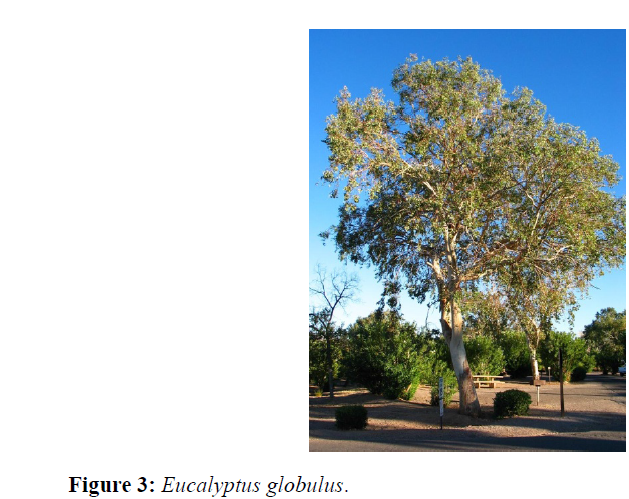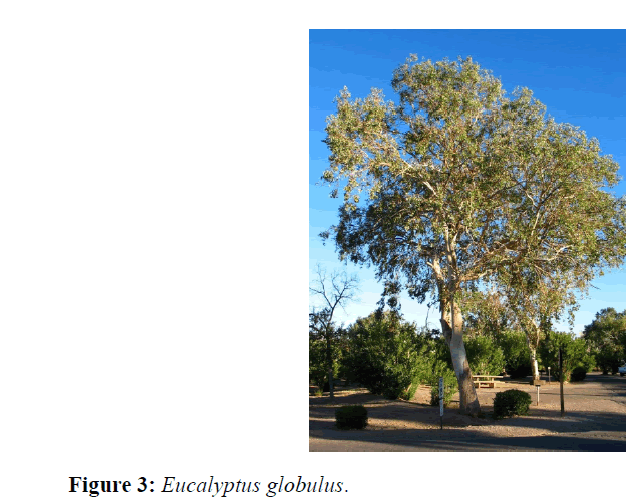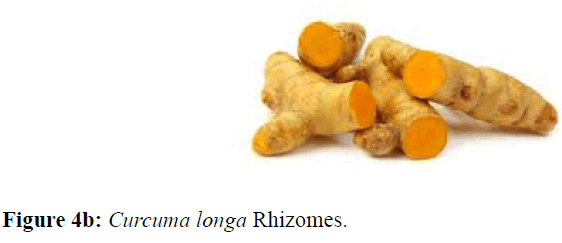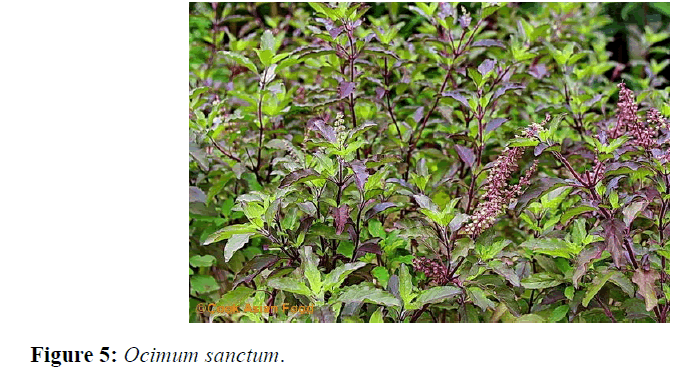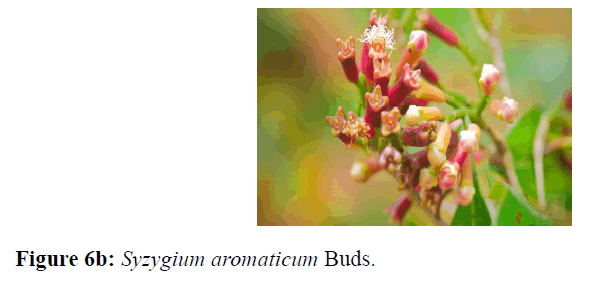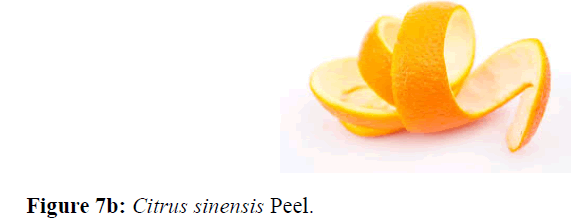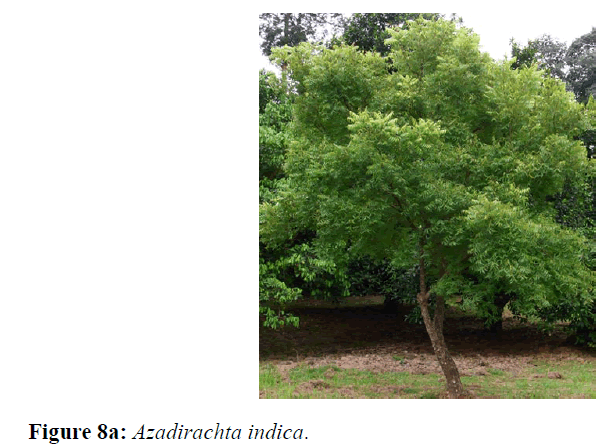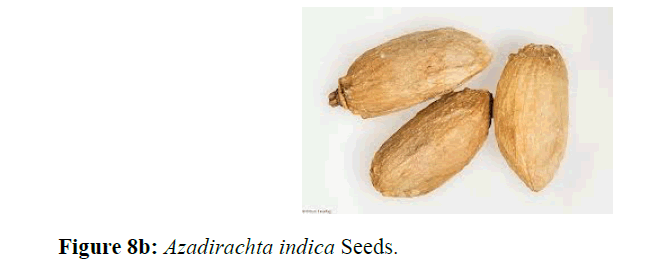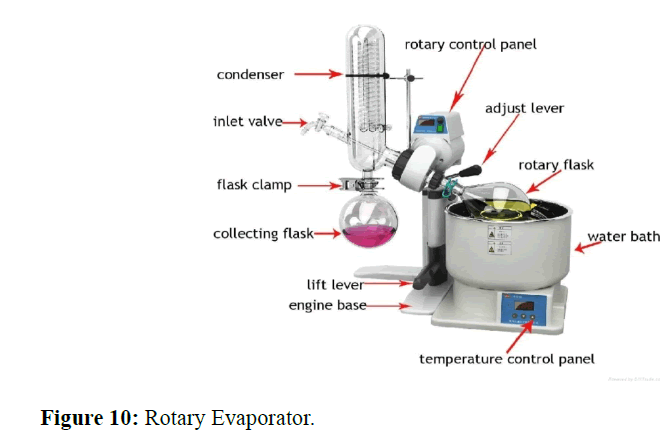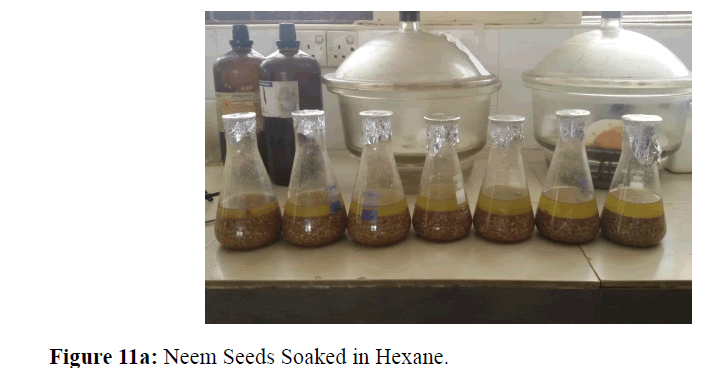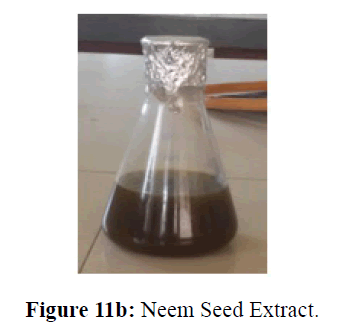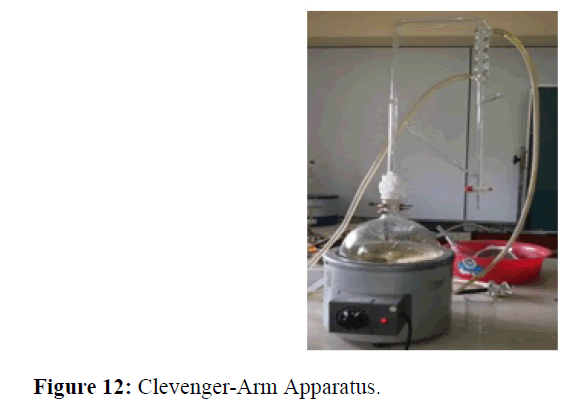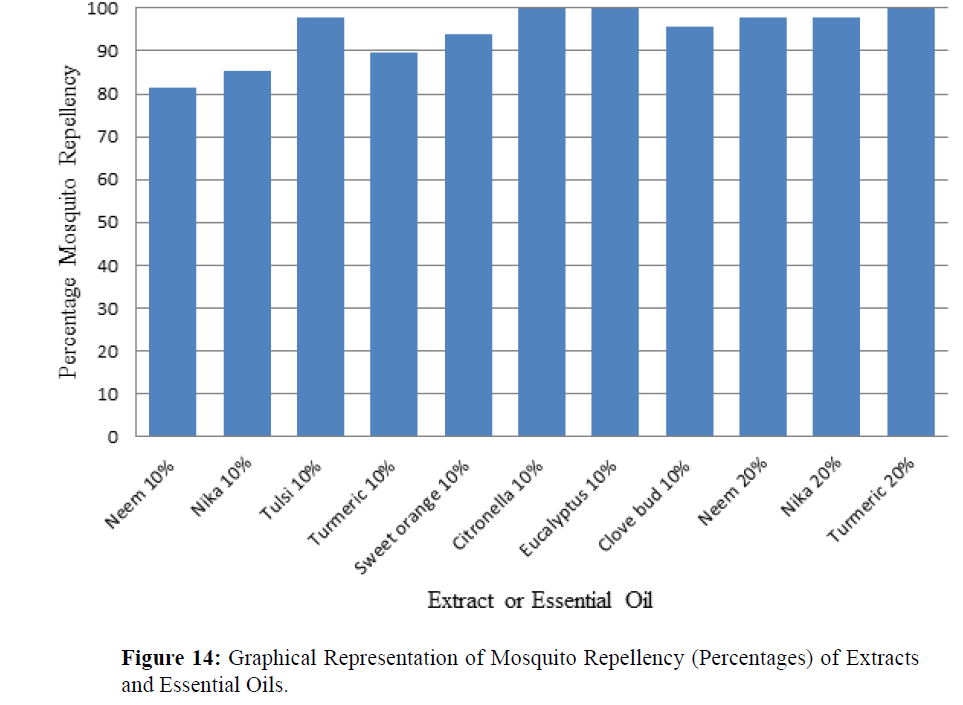Development of Herbal Mosquito Repellent Formulations
Ranasinghe MSN, Arambewela L, Samarasinghe S
Ranasinghe MSN1*, Arambewela L1, Samarasinghe S2
1College of Chemical Sciences, Institute of Chemistry Ceylon, Rajagiriya, Sri Lanka
2Medical Research Institute, Colombo, Sri Lanka
- *Corresponding Author:
- Ranasinghe MSN
College of Chemical Sciences
Institute of Chemistry Ceylon
Rajagiriya, Sri Lanka
Tel: +940785518681
E-mail: nipunisashi@yahoo.com
Abstract
The present study was conducted to determine the mosquito repellent activities of some selected plant materials in order to obtain safe and efficient herbal mosquito repellent formulations by combinations of the selected plant materials. Azadirachta indica1 seeds were socked in hexane overnight and extract was filtered and the filtrate was concentrated by rotary evaporator. Same procedure was carried out for Vitex negundo2 leaves using hexane and ethanol solvents. Hydro-distillation process was performed for Ocimum sanctum3 leaves, Curcuma longa4 rhizomes and Citrus sinensis5 peels using Clevenger-arm apparatus in order to obtain the essential oils. Essential oils of Cymbopogon nardus4 leaves, Eucalyptus globulus6 leaves and Syzygium aromaticum1 buds were purchased from a reliable source. 10% (V/V%) extract/essential oil containing ethanol solutions were prepared using each plant extract/essential oil and mosquito repellent activity testing was carried out using arm-in-cage method. Volunteer’s forearm which had been rubbed with 1 ml of the test solution was exposed to the cage where 20 blood-seeking mosquitoes had been placed and the number of mosquitoes that aligned or biting the arm was recorded in each minute for five minutes. Three replicates were carried out for each extract/essential oil containing ethanol solutions. After analysing the mosquito repellent activity of individual extracts and essential oils, a mosquito repellent gel and a mosquito repellent spray which contained 16% (V/V%) active ingredients each were prepared. Outdoor and indoor field trials were conducted in two days from 5 am to 11 am by separately applying the mosquito repellent gel and the mosquito repellent spray on volunteers’ legs. The gel and the spray showed 100% mosquito repellency for outdoor and indoor field trials which were carried out for six hours each day for two days.
Keywords
Mosquito repellent activity, Plant extract, Essential oil
Introduction
Mosquitoes are among the most disturbing blood sucking insects afflicting human beings [1]. Several mosquito species belonging to genera Anopheles, Culex and Aedes are vectors for the pathogens of various diseases like Dengue fever, Malaria, Yellow fever, Japanese Encephalitis and several other infections.[2] Mosquitoes alone transmit diseases to more than 700 million people and over one million deaths are reported annually across the globe.[3,4] Malaria which is caused by Plasmodium parasites transmitted through the bites of female Anopheles mosquitoes continues to impart a major disease burden on infants and young children in endemic regions.[4,5] In 2012, there were about 207 million cases of Malaria and an estimated 627,000 deaths all around the globe [4]. Malaria has been endemic in Sri Lanka for many centuries and several major epidemics have occurred. The most devastating of these was in 1934 - 1935 during which approximately 1.5 million individuals contracted the disease and over 80,000 people died from Malaria. More recently the country has steadily reduced the Malaria burden from over 400,000 cases in 1991 to zero cases by November 2012, sustaining this achievement to date. Since then, Sri Lanka is free of locally acquired Malaria until now. Yet, Sri Lanka is continuing to be burdened with imported Malaria from India, Pakistan and African countries. [6] Japanese Encephalitis virus is transmitted to humans through infected Culex mosquitoes. Japanese Encephalitis causes an estimated 50,000 cases and 10,000 deaths every year worldwide.[4] In Sri Lanka, there were less than 100 cases of Japanese Encephalitis reported in 2014.[7] Moreover, every year there are around 200,000 cases of illness and 30,000 deaths worldwide from Yellow fever which is transmitted by the Haemagogus and Aedes species of mosquitoes between monkeys and humans. [4]
The Aedes aegypti mosquito which spreads Dengue fever is responsible for more than 100 million infections worldwide every year, leading to thousands of deaths and more than 2.5 billion people or over 40% of the world’s population are now at risk of Dengue.[4] In Sri Lanka, large cyclical Dengue epidemics have occurred at regular intervals and in 2014, over 47,000 cases were reported.[8] Therefore, the control of mosquitoes is an important public health concern around the world. One of the approaches for control of these mosquito-borne diseases is the interruption of disease transmission by either killing the mosquitoes or preventing them from biting individuals.[2]
Kingdom: Animalia
Phylum : Arthropoda
Class : Insecta
Order : Diptera
Family : Culicidae [10]
Mosquitoes are relatively small insects which compose the family Culicidae. As shown in Figure 1, mosquito anatomy is divided into three basic parts, namely, head, thorax and abdomen. Mosquito’s head is consisting of sensors that help the mosquito to find and feed on people and animals. Mosquitoes have two large compound eyes covered with tiny lenses that are capable of detecting even slight movements. Simple photo-sensitive eyes are located on top of their heads to detect variations in light. Mosquito-antennae are long feathery organs which are positioned in front of their heads and those antennae contain sensitive receptors that detect carbon dioxide in human breath from distances of more than 100 feet. The maxillary palp between the antennae picks up the odour of ocentol and other chemicals released in human sweat. Right in the middle, also between the antennae, is the proboscis, a long serrated mouth-part used to pierce the skin and suck out blood. The thorax is connected to the head and it has a pair of wings. The legs also come out of the thorax, six in all, with tiny claws at the end of each to help the mosquitoes stay attached to surfaces. The abdomen hangs from the thorax and serves as the mosquito’s stomach and lungs.[11] Normally, both male and female mosquitoes use plant juice as food. Male mosquitoes will not bite human beings and female mosquitoes start biting human beings after mating with males as female mosquitoes require human blood protein for the maturation of their eggs.[12] Therefore, some of these female mosquitoes act as vectors for diseases. Typically, these mosquitoes transmit diseases from one human or animal to another by picking up a virus or parasite along with the blood meal while biting an infected human or animal. The mosquito and the virus do not harm one another but the virus reproduces inside the mosquito. Later, the mosquito passes the viruses to other humans while biting.[13] A mosquito repellent is a substance applied to skin, clothing or other surfaces which discourages mosquitoes from landing or climbing on that surface.[14] Usually, mosquito repellents work by masking human scent or by using a scent which mosquitoes naturally avoid.[14,15] Carbon dioxide and lactic acid present in sweat in warm-blooded animals act as an attractive substance for mosquitoes. The perception of the odour is through chemo-receptors which are present in the antennae of mosquitoes. [15] The repellents block the lactic acid receptors and destroy upwind flight. Therefore, mosquitoes lose its contact with the host.[14] Controlling mosquitoes is of utmost importance in the present-day scenario with rising numbers of mosquito-borne diseases. An alarming increase in the range of mosquitoes is mainly due to deforestation, industrialised farming and stagnant water. Thus, special products like mosquito repellents for combating mosquitoes are required.[15] The use of mosquito repellent compounds dates back to antiquity.[16] Prior to the discovery of synthetic organic insecticides, herbal products such as Nicotine from Nicotiana tabacum (Tobacco) leaves, alkaloids extracted from Anabasis aphylly (Russian weed), Rotenone from Derris elliptical and Pyrethrums from Chrysanthemum cinererifolium flower were used as natural mosquito repellents in the interruption of the transmission of mosquito-borne diseases both at the individual and the community level.[2] Before the Second World War, there were only four principal repellents, namely, Citronella oil, Dimethyl Phthalate, Indalone® and Rutgers 612. Other military-developed mosquito repellent formulae for use on clothing were developed during the war, but they all failed to provide the desired protection of military personnel deployed around the world. As a result, by 1956, the United States government had screened over 20,000 potential mosquito repellent compounds. In 1953, the mosquito and other insect repellent properties of N, Ndiethyl- 3-toluamide (DEET) were discovered and the first DEET product was introduced in 1956. DEET spray is still the most widely used mosquito repellent. It has generally been regarded as safe. However, toxic effects have been recorded, including encephalopathy in children, urticaria syndrome, anaphylaxis, hypotension and decreased heart rate. Several other compounds have been evaluated for repellent activity, but none has had the commercial success of DEET.[16]
Nowadays, there are many types of mosquito repellents which are commercially available. Spray mosquito repellents are very common and maybe sprayed on the clothing or skin. Some of the best sprays contain high concentrations of DEET and are effective for several hours even when walking through deep woods where there are thousands of mosquitoes.[5] Cream or lotion repellents are applied directly to the skin and rubbed in creating a repellent barrier. Mosquito repellent clothing is specially designed with tight fiber weave and infused with a long-lasting natural mosquito repellent to prevent mosquito bites.[17] Additionally, mosquito coils are also widely known as efficient mosquito repellents. The major active ingredient of the mosquito coils is Pyrethrins, accounting for about 0.3-0.4% of coil mass. When a mosquito coil is burned, the insecticides evaporate with the smoke which will then prevent the mosquitoes from entering the room. However, many people dislike the smell of the mosquito coils when they are burnt as people feel that the coils maybe harmful for their health as it cause headache, nausea and dizziness.[18] Currently, mosquito repellent liquidizers are also widely used all around the world. The mosquito repellant liquidizers contain synthetic Pyrethroids that produce neurological toxicity on accidental ingestion. Recently, these are emerging as a source of hydrocarbon poisoning.[19] There are physical methods to repel mosquitoes such as mosquito nets which are considered as better protection from mosquitoes than coils and other repellents that cause health hazards. Sleeping under mosquito netting can guarantee the protection from mosquitoes. Nowadays, some of the mosquito nets are medicated by using 25% Deltamethrin and these nets are considered to be safer than mosquito coils and liquidizers as inhalation of chemicals from coils and liquidizers cause respiratory tract infections and headaches. In addition, there are mosquito traps which mimic the different mosquito attractants such as exhaled carbon dioxide, human scents and body heat. Attracted by these chemicals, mosquito approaches and an impeller fan draws it in. It is then adhered to a sticky surface on the device and is eventually electrocuted. Moreover, there are mechanical methods such as Electric Mosquito Zappers that work by using ultraviolet light to lure in mosquitoes and then kill them upon contact with its lethal dose of electrical charge.[14]There are also mosquito repellent products available based on sound productions, particularly ultrasound. After mating once, female mosquitoes will not mate with males again and they avoid the presence of males. Females detect the presence of males by sensing the ultrasound produced by the males. Therefore, an ultrasound generator imitates the sound waves produced by the beating of male mosquitoes’ wings and this will repel female mosquitoes. However, this theory is implausible since the hearing ability of the females is relatively weak. It is the hearing system of males that is relatively strong and the presence of numerous sound and vibration receptors on their plumose antennae enable them to detect the vibrations in the environment as well as the sound of female mosquitoes. Thus, ultrasound waves are not effective in repelling mosquitoes.[20] Since the discovery of DDT, mosquito control approaches have been almost completely based on synthetic organic insecticides. However, the extensive use of synthetic insecticides during the last five decades has resulted in environmental hazards and also in the development of physiological resistance in major vector species.[2] Even though, mosquito repellents based on chemicals have remarkable safety profiles, they are toxic against the human skin and nervous system and may cause rashes, swelling and eye irritations.[15] This has therefore necessitated the need for research and development of environmentally safe, biodegradable, low cost, indigenous methods for vector control which can be used with minimum care by individuals and communities.[2]
According to the past researches, the essential oils of the leaves of Cymbopogon nardus (Citronella),[15,21] Cymbopogon citratus (Lemongrass), [2,16] Cymbopogon winterianus (Citronella),[1,22] Ocimum basilicum (Sweet Basil), [2] Ocimum sanctum (Tulsi), [23] Ocimum americanum (Hairy Basil), [22] Eucalyptus citriodora (Eucalyptus),[15] Eucalyptus globulus (Eucalyptus), [24] Rosmarinus officinalis, [23] Melissa officinalis, [24] Curcuma longa (Turmeric) rhizomes, [21,25] Citrus sinensis (Sweet Orange) peels, [2] Citrus hystrix (Kaffir Lime) peels, [22] Citrus limonum (Lemon) peels, [24] Syzygium aromaticum (Clove) buds [1] and Pinus roxburghii resins [1] have shown very high mosquito repellent activity. Moreover, the extracts of Azadirachta indica (Neem) seeds, [1,21,26] leaves of Alpinia galangal (Greater Galangale), [15] Vitex negundo (S. Nika) [27] and Tribulus terrestris (S. Gokatu) [3] also have been studied as possible mosquito repellents. The selection of these plants was based on their availability as raw materials, scientific evidence and folkloric use as mosquito repellents.
Cymbopogon nardus (Citronella)
Kingdom : Plantae
Order : Poales
Family : Poaceae
Genus : Cymbopogon
Species : C. nardus [29]
Cymbopogon nardus or Citronella grass (S. Pengiri) is a coarse and clump-forming tropical grass native to Sri Lanka. [30,31] Citronella grass can grow up to 1.5-1.8 m tall and citronella stems are like canes. [31] Citronella essential oil is extracted by steam-distillation of citronella leaves. Citronella essential oil is used as an insect repellent and it can be found in dozens of registered pesticide products such as sprays, lotions and candles. Due to its antifungal properties, citronella oil is also used to treat insect bites. Additionally, citronella essential oil is one of the most common oils used in aromatherapy as it has an ability to treat and prevent fever and headache. The oil of citronella is also widely used in fragrances and personal care products. Because of citronella oil’s antiseptic properties, it is used in soaps, household cleaners and detergents. Moreover, citronella oil is added as a food and beverage flavouring, (Figure 2) such as in alcoholic drinks and frozen dairy.[32] The main components of citronella essential oil are monoterpene hydrocarbons and alcohols such as geraniol (18-20%), citronellal (5-15%), citronellol (6.4-8.4%), limonene (9-11%) and geranyl acetate (2%).32 Additionally, methyl eugenol, camphene, nerol, borneol, citronellic acid and citral are also present in citronella essential oil.[33]
Eucalyptus globulus
Kingdom : Plantae
Order : Myrtales
Family : Myrtaceae
Genus : Eucalyptus
Species : E. globulus [35]
Eucalyptus globulus (S. Eucalyptus) is named as “Blue Gum” and it is a medium to very tall forest tree which may reach 70 m in ideal conditions. However, Eucalyptus globulus is more commonly 15-25 m in height and it has a rough, grayish bark which is shed on the upper trunk and branches in long ribbons. [36] Eucalyptus globulus leaves are glossy, dark green, thick and leathery.[37] The white flowers occur from winter to early summer and they are followed by hard, woody-capsules containing grayish fruits which are named as “Gum Nuts”.[36,37]
Eucalyptusessential oilwhich is extracted by steam-distillation of eucalyptus leaves is taken orally for pain and inflammation of respiratory tract mucous membranes, coughs, asthma and bronchitis. It is also used as an antiseptic, insect repellent and treatment option for wounds. Eucalyptus oil (Figure 3) is also popularly used as a fragrance in perfumes and cosmetics and it is found in mouthwashes, toothpastes and cough drops as well.[38] The main chemical constituent present in eucalyptus oil is 1,8-cineole (60-70%). In addition, α-pinene (9%), β-pinene (0.4%), limonene (0.04%), terpinen-4-ol (0.3%), aromadendrene (2.5%), epiglobulol (0.4%) and globulol (2.7%) are also present in eucalyptus oil.[38,39]
Curcuma longa (Turmeric)
Kingdom : Plantae
Order : Zingiberales
Family : Zingiberaceae
Genus : Curcuma
Species : C. longa [42]
Curcuma longa (Turmeric) is an upright, relatively short and stout plant that rarely grows more than about 1 m in height. Its leaves are elongated, dark green, and pointed, often curling slightly along the margins. Each leaf arises on an individual stalk directly from the fleshy rhizome at its base. As shown in Figure 4a and Figure 4b, the rhizome appears scaly due to the remaining rings of previous leaves. Its outer skin is brownish but its flesh is deep orange-yellow inside. Rhizomes grow to about 5-8 cm x 1.5-2.5 cm The flower stalk will appear among the leaves, also directly rising from the rootstock. The yellow-reddish flowers are arranged spirally along the cylindrical spike which may be partially protected by a leaf sheath.[43]
Turmeric is mainly used in culinary preparations and for medicinal purposes. Turmeric when used in powdered form can provide a specific taste and a rich yellow colour in food preparations. For chemical purposes, it is used as an indicator and can identify a base. Turmeric turns red when it comes in contact with a base. [44] Monoterpene hydrocarbons (46.9%) constitute the bulk of the Curcuma longa rhizome essential oil which is obtained by hydro-distillation and has antiseptic and anti-carcinogenic properties. Major constituents of the essential oil are β-bisabolene (13.9%), transocimene (9.8%), myrcene (7.6%), 1,8-cineole (6.9%), α-thujene (6.7%) and thymol (6.4%).[45]
Ocimum sanctum (Tulsi)
Kingdom : Plantae
Order : Lamiales
Family : Lamiaceae
Genus : Ocimum
Species : O. tenuiflorum [47]
Ocimum sanctum or Tulsi is a branched sub-shrub which is 30-60 cm tall, with simple opposite green or purple leaves that are strongly scented. Tulsi leaves have petiole and are ovate, up to 5 cm long, usually slightly toothed. Flowers (Figure 5) are purplish in elongate racemes in close whorls. Tulsi is native throughout the tropics and wide-spread as a cultivated plant. It is cultivated for religious and medicinal purposes and for its essential oil. [48]
Tulsi essential oil is used as a medicine for fever, headache, lung disorders, heart disorders and many other diseases. Tulsi essential oil has antibacterial, anti-viral and anti-fungal properties as well. Tulsi essential oil is also used in massage oils, perfumes, aromatherapy baths, soap making and candle making.[49] Tulsi leaf essential oil contains methyl eugenol (46-68%), (E)-caryophyllene (17-27%) and β-elemene (16.3%) as the major constituents.[50]
Syzygium aromaticum (Clove)
Kingdom : Plantae
Order : Myrtales
Family : Myrtaceae
Genus : Syzygium
Species : S. aromaticum [53]
Syzygium aromaticum (Clove) is a triangular-shaped evergreen tree growing about 12 m tall with a smooth grey bark and about 12 cm long, glossy opposite leaves that resemble bay leaves. The attractive red and white bell-shaped flowers have four tiny petals surrounded by a long, four- parted calyx and numerous stamens. The clove buds, shown in Figure 6a and Figure 6b, are pink but calyx changes from yellow to deep red after the stamens fall. The fruit, called mother of cloves, is an edible purple berry about 2.5 cm long. The entire Syzygium aromaticum plant is extremely aromatic.[51]
Cloves are used in cooking, either in whole or in ground form as a spice throughout Europe and Asia. Clove essential oil is widely used and well known for its medicinal properties. Traditional uses of clove oil include use in dental care as an antiseptic and analgesic. The oil is active against oral bacteria associated with dental caries and periodontal diseases. Additionally, clove oil has anti-carcinogenic, anti-allergic, antioxidant and insecticidal properties. The major constituent in clove bud oils is eugenol (72.08-82.36%) and eugenyl acetate is the second major component (8.6-21.3%). In addition, β-caryophyllene (2.76-8.64%) and α-humulene (0.34-1.04%) also see present in clove bud oil. [54]
Citrus sinensis (Sweet Orange)
Kingdom : Plantae
Order : Sapindales
Family : Rutaceae
Genus : Citrus
Species : C. sinensis [57]
Citrus sinensis or Sweet Orange is a small shallow-rooted evergreen tree which is about 6-13 m in height with enclosed conical top and spiny branches. Citrus sinensis leaves which are 5-15 cm long and 2-8 cm wide are dark green in colour, glossy and ovalshaped. Greenish-white Citrus sinensis flower is small and it has five petals. Citrus sinensis fruits are reddish-green to yellowish-green in colour and consist of a leathery and tightly adhered peel which is 6 mm thick. Citrus sinensis peel, shown in Figure 7a and Figure 7b, protects the juicy inner pulp of the Sweet Orange fruit.[58]
Sweet Orange peels, leaves and flowers contain fine essences of oils that are used in the manufacture of cosmetic products and medicines. The main chemical components of Sweet Orange peel essential oil are α-pinene, sabinene, myrcene, limonene, linalool, citronellal, neral and geranial. [59]
Azadirachta indica (Neem)
Kingdom : Plantae
Order : Sapindales
Family : Meliaceae
Genus : Azadirachta
Species : A. indica [62]
Azadirachta indica is an evergreen and fast-growing tree that can reach a height of 15-20 m. The Neem branches are spread widely. The fairly dense crown is roundish or oval. The white and fragrant flowers arise from the junction of the stem and petiole. An individual flower is 5-6 mm long and 8-11 mm wide. Neem fruit is a smooth olivelike drupe. The fruit skin is thin and turns yellow when ripe. The bitter-sweet pulp is yellowish-white. The white, hard inner shell of the fruit encloses one, rarely two or three, elongated seed having a brown seed coat as shown in Figure 8a and Figure 8b.[63] All parts of the tree such as seeds, leaves, flowers and bark, are used in the preparing of various different medical preparations. Neem products have medicinal properties that prove to be anti-fungal, anti-diabetic, antibacterial, antiviral and anti-fertility. [62]
Limonoid compounds contained in Neem seed extract seem to have the insecticide and pesticide properties. The main limonoid in Neem seed extract is azadirachtin. Additionally, azadiradione, fraxinellone, nimbin, salannin, salannol, vepinin and vilasinin are also present in Neem seed extract. Bitter property of the Neem oil is due to tannins, flavonoids and sesquiterpene derivatives. [64]
Vitex negundo (Nika)
Kingdom : Plantae
Order : Lamiales
Family : Verbenaceae
Genus : Vitex
Species : V. negundo [27]
Vitex negundo or Nika is a branched, small and slender tree which grows up to 4.5-5.5 m in height, flourishing mainly in the Indian subcontinent. Vitex negundo (Figure 9) leaf upper surface is green and the lower surface is silvery in colour. Flower is bluish purple and becomes black when ripe. All parts of the plant, from root to fruit, possess a multitude of phyto-chemical secondary metabolites which impart an unprecedented variety of medicinal uses to the plant. [27] The hexane extract of Vitex negundo leaf contains viridiflorol (19.55%), β-caryophyllene (16.59%), sabinene (12.07%), 4- terpineol (9.65%), γ-terpinene (2.21%), caryophyllene (1.75%), 1-ocetene-3-ol (1.59%) and globulol (1.05%). [27] Ethanol extract of Vitex negundo leaf contains flavonoids as the major constituents along with a few terpenoids. [65]
The Objective of the Study
As most of the mosquito repellent products and devices available in the market are reported to have harmful effects on human beings, the objective of the present study is to develop effective plant-based mosquito repellent products.
Materials and Methods
A small quantity of each plant material, about 5 gm, was weighed and then it was heated in an oven at 105°C for about 5 hours until a constant weight was obtained. Then the final constant weight of the dried plant material was measured and the moisture content was determined. Rotary evaporator which is shown in Figure 10 removes solvents from samples by applying heat to the rotary flask at a reduced pressure. Rotating the flask throws up liquid on the walls of the flask and thus increases the surface area for evaporation. Heat is often applied to the rotating distillation flask by partially immersing it in a heated bath of water. As the machine utilises a lower pressure than the atmospheric pressure, the solvent is evaporated at a temperature which is lower than its boiling point and it ensures that the solutes dissolved in the sample are not decomposed.
Preparation of Azadirachta indica (Neem) seed extract
Azadirachta indica (Neem) seeds were purchased from an Ayurvedic shop.
Materials
Azadirachta indica (Neem) seeds - 966.67 gm
Hexane - 1,960 ml
Crushed Azadirachta indica (Neem) seeds were soaked in hexane overnight at room temperature with occasional shaking as shown in Figure 11a. The hexane extract was filtered and the filtrate was concentrated by rotary evaporator at around 45°C same procedure was carried out for the second extraction using squeezed Neem seeds. Finally, the total extract, shown in Figure 11b, was weighed and stored in refrigerator at 4°C until it was used for the experiment.
Preparation of Vitex negundo (Nika) leaf extract
Vitex negundo (Nika) leaves were collected from Gampaha, Sri Lanka and were identified using botanical features.
Materials
Vitex negundo (Nika) leaves - 835.72 gm
Hexane - 3,500 ml
Ethanol - 3,000 ml
Vitex negundo (Nika) leaves were cut into small pieces and were soaked in hexane solvent overnight at room temperature with occasional shaking. Then, the hexane extract was filtered and the filtrate was concentrated by rotary evaporator less than 45°C. Same procedure was repeated using squeezed Nika leaves and hexane solvent. Finally, the total extract was weighed and stored in refrigerator at 4°C until it was used for the experiment.
The leaves that were extracted with hexane were soaked in ethanol solvent for one day at room temperature with occasional shaking. Then the ethanol extract was filtered and concentrated using the rotary evaporator (55-60°C). Same procedure was carried out for the second extraction using squeezed Nika leaves. Finally, the total extract was weighed and stored in refrigerator at 4°C until it was used for the experiment. For the experiment, hexane extract of Nika and ethanol extract of Nika were mixed together in 1:1 ratio.
Preparation of the essential oils by hydro-distilation using clevenger-arm apparatus
Ocimum sanctum (Tulsi) leaves were obtained from Industrial Technology Institute (ITI), Sri Lanka.
Curcuma longa (Turmeric) rhizomes were purchased from an Ayurvedic shop.
Citrus sinensis (Sweet Orange) peels were collected from Sigiriya, Sri Lanka.
Materials
Ocimum sanctum (Tulsi) leaves - 718.90 g
Curcuma longa (Turmeric) rhizomes - 700.00 g
Citrus sinensis (Sweet Orange) peels - 1,144.52 g
Mixture of Dicholoromethane and Diethyl Ether (1:1 ratio)Hydro-distillation process was performed for each plant material separately using Clevenger-arm apparatus shown in Figure 12. Water was added to the weighed quantity of plant material in a round bottom flask which was placed on a heating mantle and the flask was connected with the Clevenger-arm apparatus. Flow of water was allowed to run in the condenser. While boiling, the volatile oils were carried along with the steam into the graduated distillate receiving tube and excess water returned to the flask. A layer of solvent, mixture of dichloromethane and diethyl ether, was added to the distillation arm. The essential oils dissolved in the organic solvent mixture which was in the graduated distillate receiving arm. Heating was continued for about 5 hours and assembly was allowed to cool. At last, aqueous layer and organic layer were collected separately. Then the organic layer was allowed to dry over anhydrous Sodium Sulphate and aqueous layer was extracted twice with dichloromethane. Finally, the combined solvents were evaporated and essential oil was obtained. Essential oilwas weighed and stored in refrigerator at 4oC until it was used for the experiment.
Purchase of commercially available essential oils
Essential oils of Cymbopogon nardus (Citronella) leaves, Eucalyptus globulus (S. Eucalyptus) leaves and Syzygium aromaticum (Clove) buds were purchased from Citro Essential Oils (PVT) Ltd, Sri Lanka.
Preparation of the test solutions
10% (V/V%) extract or essential oil containing ethanol solutions were prepared using each plant extractand essential oil. 0.3 ml of each plant extract or essential oil was mixed with 3 drops of Tween 80. Then ethanol was added until the volume was 3 ml. 20% (V/V%) extract or essential oil containing ethanol solutions were separately prepared using Neem extract, Nika extract and Turmeric essential oil. 0.6ml of each plant extract or essential oil was mixed with 3 drops of Tween 80. Then ethanol was added until the volume was 3ml. In order to prepare the control test solution, ethanol was added to 3 drops of Tween 80, until the volume was 3 ml.
Testing the mosquito repellent activity of extracts and essential oils using arm-in-cage method
The mosquitoes used in this experiment were caught using a net while biting humans between 7 pm and 10 pm. Mosquitoes were starved for 24 hours and 20 mosquitoes were placed in the cage (45 × 15 × 30 cm) shown in Figure 13.
Test timing was between 7 pm and 10 pm since the mosquitoes typically bite at night. Host-seeking behaviour of the mosquitoes was tested prior to the experiment. This was done by placing a pre-cleaned hand in the cage and counting the number of mosquitoes that aligned within 10 seconds. If at least 5 mosquitoes aligned on the hand, the mosquitoes inside the cage were regarded as host-seeking and the repellency experiment was continued.
Volunteer’s forearm which had been rubbed with 1 ml of the test solution was exposed to the cage and the number of mosquitoes that aligned or biting the arm was recorded in each minute for 5 minutes. Mosquitoes were given an over one hour interval and the above procedure was followed for each of the other extracts and essential oils. Each test was repeated thrice to get a mean value of mosquito repellent activity.
Preparation of the mosquito repellent gel
Considering the experimental results obtained using arm-in-cage method and the available quantities of the extracts and the essential oils, the gel was prepared by mixing the constituents in Table 1. The total active ingredients in the gel was 16% (V/V%). Distilled water was added to the mixture until the final volume was 400.00 ml and all the constituents were mixed using the mechanical stirrer for one hour. Finally, the mixture was poured into plastic containers and the gel was allowed to set.
| Constituents | Quantity |
|---|---|
| Citronella essential oil | 10.00 ml |
| Eucalyptus essential oil | 10.00 ml |
| Tulsi essential oil | 3.00 ml |
| Clove bud essential oil | 7.00 ml |
| Sweet Orange peel essential oil | 6.00 ml |
| Turmeric essential oil | 4.00 ml |
| Nika extract | 12.00 ml |
| Neem extract | 12.00 ml |
| Hexane | 6.00 ml |
| Ethanol | 5.00 ml |
| Carbapol | 5.00 g |
| Propylene glycol | 20.00 ml |
| Methyl paraban | 0.50 g |
| Tween 80 | 6.00 ml |
| Triethanol amine | Few drops to adjust the pH to 7 |
| Distilled water | 293.50 ml |
Table 1: The Constituents in the Mosquito Repellent Gel.
Preparation of the mosquito repellent spray
Considering the experimental results obtained using arm-in-cage method and the available quantities of the extracts and the essential oils, the spray was prepared by mixing the constituents in Table 2. The total active ingredients in the spray was 16% (V/V%). Distilled water was added to the mixture until the final volume was 400.00 ml and all the constituents were mixed using the magnetic stirrer for one hour. Finally, the mixture was poured into bottles.
| Constituents | Quantity |
|---|---|
| Citronella essential oil | 10.00 ml |
| Eucalyptus essential oil | 10.00ml |
| Tulsi essential oil | 3.00 ml |
| Clove bud essential oil | 7.00 ml |
| Sweet Orange peel essential oil | 6.00 ml |
| Turmeric essential oil | 4.00 ml |
| Nika extract | 12.00 ml |
| Neem extract | 12.00 ml |
| Hexane | 6.00 ml |
| Ethanol | 100.00 ml |
| Tween 80 | 30.00 ml |
| Distilled water | 200.00 ml |
Table 2: The Constituents in the Mosquito Repellent Spray.
Bio-efficacy testing of the mosquito repellent gel and the mosquito repellent spray
Bio-efficacy tests of the mosquito repellent gel and the mosquito repellent spray were done in collaboration with Medical Research Institute, Sri Lanka.
Outdoor and indoor field trials were conducted in two days from 5 am to 11 am by separately applying the mosquito repellent gel and the mosquito repellent spray on volunteers’ legs. Untreated legs of another volunteer were used as control for this experiment.
Results and Calculations
Table 3 gives the textures of the extracts and the essential oils obtained in the laboratory and the textures of the purchased essentials oils.
| Extracts and Essential Oils | Texture | |
|---|---|---|
| Neem extract | Green-brown thick liquid | |
| Nika extracts | Hexane extract | Green solid |
| Ethanol extract | Dark-brown thick liquid | |
| Tulsi essential oil | Light yellow liquid | |
| Turmeric essential oil | Light yellow liquid | |
| Sweet Orange essential oil | Light yellow liquid | |
| Citronella essential oil | Yellow liquid | |
| Eucalyptus essential oil | Colourless liquid | |
| Clove bud essential oil | Red-brown liquid | |
Table 3: Textures of the Extracts and the Essential Oils.
The yields of the extracts and the essential oils were determined as a percentage (W/W %) using the formula,
Table 4 shows the percentage yields (W/W%) of the extracts and the essential oils which were obtained in the laboratory,
The yields of the extracts and the essential oils were determined as a percentage (W/W %) on the dry weight as follows,
| Extracts and Essential Oils | Initial Weight of the Plant Material (g) | Weight of the Extract or Essential Oil (g) | Percentage Yield (%) | |
|---|---|---|---|---|
| Neem extract | 966.67 | 156.06 | 16.14 | |
| Nika extract | Hexane extract | 835.72 | 21.41 | 2.56 |
| Ethanol extract | 835.72 | 93.12 | 11.14 | |
| Tulsi essential oil | 718.90 | 7.70 | 1.07 | |
| Turmeric essential oil | 700.00 | 12.39 | 1.77 | |
| Sweet Orange essential oil | 1144.52 | 15.01 | 1.31 | |
Table 4: Percentage Yields of the Extracts and the Essential Oils.
Initial weight of the plant material put into the oven = X g
Constant weight of the plant material after heating at 105°C = Y g
Table 5 shows the percentage yields (W/W%) of the extracts and the essential oils on the dry weight basis which were obtained in the laboratory,
| Extracts and Essential Oils | X (g) |
Y (g) |
Initial Weight of the Plant Material (g) | Weight of the Extract or Essential Oil (g) | Percentage Yield on the Dry Weight Basis (%) | |
|---|---|---|---|---|---|---|
| Neem extract | 5.32 | 1.85 | 966.67 | 156.06 | 46.43 | |
| Nika extract | Hexane extract | 4.16 | 1.39 | 835.72 | 21.41 | 7.67 |
| Ethanol extract | 4.16 | 1.39 | 835.72 | 93.12 | 33.35 | |
| Tulsi essential oil | 4.25 | 1.87 | 718.90 | 7.70 | 2.43 | |
| Turmeric essential oil | 4.26 | 0.50 | 700.00 | 12.39 | 15.08 | |
| Sweet Orange essential oil | 5.48 | 0.68 | 1144.52 | 15.01 | 10.57 | |
Table 5: Percentage Yields of the Extracts and the Essential Oils on the Dry Weight Basis.
Table 6 indicates the number of mosquitoes which aligned/left and aligned/bit the volunteer’s treated area of the arm out of 20 mosquitoes within 5 minutes of an exposure time to the mosquito cage in replicate 1.
| Replicate 1 | ||||
|---|---|---|---|---|
| Extracts and Essential Oils | Exposure Time (min) | Number of Mosquitoes Aligned/Left | Number of Mosquitoes Aligned/Bit | Total Number of Mosquitoes Aligned/Left and Aligned/Bit |
| Neem extract 10% (V/V%) |
1 | 0 | 0 | 4 |
| 2 | 1 | 0 | ||
| 3 | 0 | 0 | ||
| 4 | 1 | 1 | ||
| 5 | 0 | 1 | ||
| Nika extract 10% (V/V%) |
1 | 0 | 0 | 3 |
| 2 | 1 | 0 | ||
| 3 | 0 | 1 | ||
| 4 | 0 | 1 | ||
| 5 | 0 | 0 | ||
| Tulsi essential oil 10% (V/V%) |
1 | 0 | 0 | 0 |
| 2 | ||||
| 3 | ||||
| 4 | ||||
| 5 | ||||
| Turmeric essential oil 10% (V/V%) |
1 | 0 | 0 | 2 |
| 2 | 1 | |||
| 3 | 0 | |||
| 4 | 0 | |||
| 5 | 1 | |||
| Sweet Orange essential oil 10% (V/V%) |
1 | 0 | 0 | 1 |
| 2 | 0 | |||
| 3 | 0 | |||
| 4 | 1 | |||
| 5 | 0 | |||
| Citronella essential oil 10% (V/V%) |
1 | 0 | 0 | 0 |
| 2 | ||||
| 3 | ||||
| 4 | ||||
| 5 | ||||
| Eucalyptus essential oil 10% (V/V%) |
1 | 0 | 0 | 0 |
| 2 | ||||
| 3 | ||||
| 4 | ||||
| 5 | ||||
| Clove bud essential oil 10% (V/V%) |
1 | 0 | 0 | 1 |
| 2 | 0 | |||
| 3 | 0 | |||
| 4 | 1 | |||
| 5 | 0 | |||
| Neem extract 20% (V/V%) |
1 | 0 | 0 | 0 |
| 2 | ||||
| 3 | ||||
| 4 | ||||
| 5 | ||||
| Nika extract 20% (V/V%) |
1 | 0 | 0 | 1 |
| 2 | 0 | |||
| 3 | 0 | |||
| 4 | 0 | |||
| 5 | 1 | |||
| Turmeric essential oil 20% (V/V%) |
1 2 3 4 5 |
0 | 0 | 0 |
| Solvent (Ethanol and Tween 80) | 1 | 2 | 0 | 18 |
| 2 | 3 | 2 | ||
| 3 | 0 | 2 | ||
| 4 | 3 | 3 | ||
| 5 | 2 | 1 | ||
Table 6: Results of Arm-in-Cage Method Experiment for Extracts and Essential Oils - Replicate 1.
Table 7 indicates the number of mosquitoes which aligned/left and aligned/bit the volunteer’s treated area of the arm out of 20 mosquitoes within 5 minutes of an exposure time to the mosquito cage in replicate 2.
| Replicate 2 | ||||
|---|---|---|---|---|
| Extracts and Essential Oils | Exposure Time (min) | Number of Mosquitoes Aligned/Left | Number of Mosquitoes Aligned/Bit | Total Number of Mosquitoes Aligned/left and Aligned/Bit |
| Neem extract 10% (V/V%) |
1 | 0 | 0 | 2 |
| 2 | 0 | 0 | ||
| 3 | 1 | 0 | ||
| 4 | 0 | 1 | ||
| 5 | 0 | 0 | ||
| Nika extract 10% (V/V%) |
1 | 0 | 0 | 1 |
| 2 | 0 | |||
| 3 | 1 | |||
| 4 | 0 | |||
| 5 | 0 | |||
| Tulsi essential oil 10% (V/V%) |
1 | 0 | 0 | 1 |
| 2 | 0 | |||
| 3 | 0 | |||
| 4 | 0 | |||
| 5 | 1 | |||
| Turmeric essential oil 10% (V/V%) |
1 | 0 | 0 | 3 |
| 2 | 0 | |||
| 3 | 1 | |||
| 4 | 2 | |||
| 5 | 0 | |||
| Sweet Orange essential oil 10% (V/V%) |
1 | 0 | 0 | 2 |
| 2 | 0 | |||
| 3 | 0 | |||
| 4 | 0 | |||
| 5 | 2 | |||
| Citronella essential oil 10% (V/V%) |
1 | 0 | 0 | 0 |
| 2 | ||||
| 3 | ||||
| 4 | ||||
| 5 | ||||
| Eucalyptus essential oil 10% (V/V%) |
1 | 0 | 0 | 0 |
| 2 | ||||
| 3 | ||||
| 4 | ||||
| 5 | ||||
| Clove bud essential oil 10% (V/V%) |
1 | 0 | 0 | 0 |
| 2 | ||||
| 3 | ||||
| 4 | ||||
| 5 | ||||
| Neem extract 20% (V/V%) |
1 | 0 | 0 | 1 |
| 2 | 0 | |||
| 3 | 0 | |||
| 4 | 1 | |||
| 5 | 0 | |||
| Nika extract 20% (V/V%) |
1 | 0 | 0 | 0 |
| 2 | ||||
| 3 | ||||
| 4 | ||||
| 5 | ||||
| Turmeric essential oil 20% (V/V%) |
1 | 0 | 0 | 0 |
| 2 | ||||
| 3 | ||||
| 4 | ||||
| 5 | ||||
| Solvent (Ethanol and Tween 80) | 1 | 3 | 0 | 14 |
| 2 | 1 | 2 | ||
| 3 | 3 | 0 | ||
| 4 | 2 | 1 | ||
| 5 | 2 | 0 | ||
Table 7: Results of Arm-in-Cage Method Experiment for Extracts and Essential Oils - Replicate 2.
Table 8 indicates the number of mosquitoes which aligned/left and aligned/bit the volunteer’s treated area of the arm out of 20 mosquitoes within 5 minutes of an exposure time to the mosquito cage in replicate 3.
| Replicate 3 | ||||
|---|---|---|---|---|
| Extracts and Essential Oils | Exposure Time (min) | Number of Mosquitoes Aligned/Left | Number of Mosquitoes Aligned/Bit | Total Number of Mosquitoes Aligned/Left and Aligned/Bit |
| Neem extract 10% (V/V%) |
1 | 0 | 1 | 3 |
| 2 | 0 | 0 | ||
| 3 | 0 | 0 | ||
| 4 | 2 | 0 | ||
| 5 | 0 | 0 | ||
| Nika extract 10% (V/V%) |
1 | 0 | 0 | 3 |
| 2 | 0 | 0 | ||
| 3 | 1 | 0 | ||
| 4 | 1 | 0 | ||
| 5 | 0 | 1 | ||
| Tulsi essential oil 10% (V/V%) |
1 | 0 | 0 | 0 |
| 2 | ||||
| 3 | ||||
| 4 | ||||
| 5 | ||||
| Turmeric essential oil 10% (V/V%) |
1 | 0 | 0 | 0 |
| 2 | ||||
| 3 | ||||
| 4 | ||||
| 5 | ||||
| Sweet Orange essential oil 10% (V/V%) |
1 | 0 | 0 | 0 |
| 2 | ||||
| 3 | ||||
| 4 | ||||
| 5 | ||||
| Citronella essential oil 10% (V/V%) |
1 | 0 | 0 | 0 |
| 2 | ||||
| 3 | ||||
| 4 | ||||
| 5 | ||||
| Eucalyptus essential oil 10% (V/V%) |
1 | 0 | 0 | 0 |
| 2 | ||||
| 3 | ||||
| 4 | ||||
| 5 | ||||
| Clove bud essential oil 10% (V/V%) |
1 | 0 | 0 | 1 |
| 2 | 0 | |||
| 3 | 0 | |||
| 4 | 1 | |||
| 5 | 0 | |||
| Neem extract 20% (V/V%) |
1 | 0 | 0 | 0 |
| 2 | ||||
| 3 | ||||
| 4 | ||||
| 5 | ||||
| Nika extract 20% (V/V%) |
1 | 0 | 0 | 0 |
| 2 | ||||
| 3 | ||||
| 4 | ||||
| 5 | ||||
| Turmeric essential oil 20% (V/V%) |
1 | 0 | 0 | 0 |
| 2 | ||||
| 3 | ||||
| 4 | ||||
| 5 | ||||
| Solvent (Ethanol and Tween 80) | 1 | 2 | 0 | 16 |
| 2 | 1 | 4 | ||
| 3 | 3 | 1 | ||
| 4 | 2 | 1 | ||
| 5 | 2 | 0 | ||
Table 8: Results of Arm-in-Cage Method Experiment for Extracts and Essential Oils - Replicate 3.
First, 10% (V/V%) extract or essential oil containing ethanol solutions were used to perform the experiment. As Neem and Nika extracts and Turmeric essential oil showed relatively low repellent activity, experiment was repeated for Neem extract, Nika extract and Turmeric essential oil using 20% (V/V%) extract or essential oil containing ethanol solutions. For 10% (V/V%) Nika extract and 10% (V/V%) Neem extract mosquito bites were recorded. However, for none of the other extracts and essential oils mosquito bites were recorded.
Mean value of mosquitoes aligned/left and aligned/bit shown in Table 9 was calculated using the below formula,
| Replicate 1 | Replicate 2 | Replicate 3 | ||
|---|---|---|---|---|
| Extracts and Essential Oils | Total Number of Mosquitoes Aligned/Left and Aligned/Bit | Total Number of Mosquitoes Aligned/Left and Aligned/Bit | Total Number of Mosquitoes Aligned/Left and Aligned/Bit | Mean Value of Mosquitoes Aligned/Left and Aligned/Bit |
| Neem extract 10% (V/V%) |
4 | 2 | 3 | 3.00 |
| Nika extract 10% (V/V%) |
3 | 1 | 3 | 2.33 (2) |
| Tulsi essential oil 10% (V/V%) |
0 | 1 | 0 | 0.33 (0) |
| Turmeric essential oil 10% (V/V%) |
2 | 3 | 0 | 1.67 (2) |
| Sweet Orange essential oil 10% (V/V%) |
1 | 2 | 0 | 1.00 |
| Citronella essential oil 10% (V/V%) |
0 | 0 | 0 | 0.00 |
| Eucalyptus essential oil 10% (V/V%) |
0 | 0 | 0 | 0.00 |
| Clove bud essential oil 10% (V/V%) |
1 | 0 | 1 | 0.67 (1) |
| Neem extract 20% (V/V%) |
0 | 1 | 0 | 0.33 (0) |
| Nika extract 20% (V/V%) |
1 | 0 | 0 | 0.33 (0) |
| Turmeric essential oil 20% (V/V%) |
0 | 0 | 0 | 0.00 |
| Solvent (Ethanol and Tween 80) | 18 | 14 | 16 | 16.00 |
Table 9: Mean Values of the Mosquitoes Aligned/Left and Aligned/Bit for Extracts and Essential Oils.
Percentage mosquito repellency for each extract and essential oil shown in Table 10 was calculated as below,
| Extracts and Essential Oils | Mean Value of Repelled Mosquitoes | Percentage Mosquito Repellency (%) |
|---|---|---|
| Neem extract 10% (V/V%) |
3.00 | 81.25 |
| Nika extract 10% (V/V%) |
2.33 | 85.44 |
| Tulsi essential oil 10% (V/V%) |
0.33 | 97.94 |
| Turmeric essential oil 10% (V/V%) |
1.67 | 89.56 |
| Sweet Orange essential oil 10% (V/V%) |
1.00 | 93.75 |
| Citronella essential oil 10% (V/V%) |
0.00 | 100 |
| Eucalyptus essential oil 10% (V/V%) |
0.00 | 100 |
| Clove bud essential oil 10% (V/V%) |
0.67 | 95.81 |
| Neem extract 20% (V/V%) |
0.33 | 97.94 |
| Nika extract ` 20% (V/V%) |
0.33 | 97.94 |
| Turmeric essential oil 20% (V/V%) |
0.00 | 100.00 |
Table 10: Mosquito Repellency (Percentages) of Extracts and Essential Oils.
Where, C= Number of mosquitoes aligned/left and aligned/bit when the solvent was used;
N= Number of mosquitoes aligned/left and aligned/bit when the extract or the essential oil was used
Figure 14 indicates the graphical representation of the mosquito repellency percentages of each extract and essential oil,
According to Figure 14, essential oils have shown a highermosquito repellent activity compared to extracts. When 10% (V/V%) extracts and essential oils were compared, the mosquito repellent activities were found to be in the order: Citronella essential oil and Eucalyptus essential oil > Tulsi essential oil > Clove bud essential oil > Sweet Orange essential oil > Turmeric essential oil > Nika extract > Neem extract.
10% (V/V%) Citronella essential oil and 10% (V/V%) Eucalyptus essential oil showed 100% mosquito repellent activity. However, 10% (V/V%) Neem extract, 10% (V/V%) Nika extract and 10% (V/V%) Turmeric essential oil showed relatively low mosquito repellent activity compared to other 10% (V/V%) extracts and essential oils. Therefore, the experiment was repeated for Neem and Nika extracts and Turmeric essential oil using 20% (V/V%) concentration to find the minimum concentration which repels the mosquitoes. When 20% (V/V%) Neem and Nika extracts were used, mosquito repellent activity increased up to 97.94% and 20% (V/V%) Turmericessential oil showed 100% mosquito repellent activity.
Table 11 indicates the number of mosquitoes which aligned/left and aligned/bit the volunteer’s treated area of arm out of 20 mosquitoes within 5 minutes of an exposure time to the mosquito cage in replicate 1. Control test was done using the volunteer’s untreated arm.
| Replicate 1 | ||||
|---|---|---|---|---|
| Test Repellents | Exposure Time (min) | Number of Mosquitoes Aligned/Left | Number of Mosquitoes Aligned/Bit | Total Number of Mosquitoes Aligned/Left and Aligned/Bit |
| Mosquito repellent gel | 1 | 0 | 0 | 0 |
| 2 | ||||
| 3 | ||||
| 4 | ||||
| 5 | ||||
| Mosquito repellent spray | 1 | 0 | 0 | 0 |
| 2 | ||||
| 3 | ||||
| 4 | ||||
| 5 | ||||
| Control | 1 | 2 | 1 | 17 |
| 2 | 2 | 2 | ||
| 3 | 0 | 2 | ||
| 4 | 1 | 3 | ||
| 5 | 3 | 1 | ||
Table 11: Results of Arm-in-Cage Method Experiment for the Mosquito Repellent Gel and the Mosquito Repellent Spray - Replicate 1.
Table 12 indicates the number of mosquitoes which aligned/left and aligned/bit the volunteer’s treated area of arm out of 20 mosquitoes within 5 minutes of an exposure time to the mosquito cage in replicate 2. Control test was done using the volunteer’s untreated arm.
| Replicate 2 | ||||
|---|---|---|---|---|
| Test Repellents | Exposure Time (min) | Number of Mosquitoes Aligned/Left | Number of Mosquitoes Aligned/Bit | Total Number of Mosquitoes Aligned/Left and Aligned/Bit |
| Mosquito repellent gel | 1 | 0 | 0 | 0 |
| 2 | ||||
| 3 | ||||
| 4 | ||||
| 5 | ||||
| Mosquito repellent spray | 1 | 0 | 0 | 0 |
| 2 | ||||
| 3 | ||||
| 4 | ||||
| 5 | ||||
| Control | 1 | 2 | 1 | 18 |
| 2 | 2 | 2 | ||
| 3 | 1 | 2 | ||
| 4 | 1 | 3 | ||
| 5 | 3 | 1 | ||
Table 12: Results of Arm-in-Cage Method Experiment for the Mosquito Repellent Gel and the Mosquito Repellent Spray - Replicate 2.
Table 13 indicates the number of mosquitoes which aligned/left and aligned/bit the volunteer’s treated area of arm out of 20 mosquitoes within 5 minutes of an exposure time to the mosquito cage in replicate 3. Control test was done using the volunteer’s untreated arm.
| Replicate 3 | ||||
|---|---|---|---|---|
| Test Repellents | Exposure Time (min) | Number of Mosquitoes Aligned/Left | Number of Mosquitoes Aligned/Bit | Total Number of Mosquitoes Aligned/Left and Aligned/Bit |
| Mosquito repellent gel | 1 | 0 | 0 | 0 |
| 2 | ||||
| 3 | ||||
| 4 | ||||
| 5 | ||||
| Mosquito repellent spray | 1 | 0 | 0 | 0 |
| 2 | ||||
| 3 | ||||
| 4 | ||||
| 5 | ||||
| Control | 1 | 1 | 1 | 17 |
| 2 | 2 | 2 | ||
| 3 | 2 | 1 | ||
| 4 | 1 | 3 | ||
| 5 | 3 | 1 | ||
Table 13: Results of Arm-in-Cage Method Experiment for the Mosquito Repellent Gel and the Mosquito Repellent Spray - Replicate 3.
Mean value of mosquitoes aligned/left and aligned/bit shown in Table 14 was calculated using the below formula,
| Replicate 1 | Replicate 2 | Replicate 3 | ||
|---|---|---|---|---|
| Test Repellents | Total Number of Mosquitoes Aligned/Left and Aligned/Bit | Total Number of Mosquitoes Aligned/Left and Aligned/Bit | Total Number of Mosquitoes Aligned/Left and Aligned/Bit | Mean Value of Mosquitoes Aligned/Left and Aligned/Bit |
| Mosquito repellent gel | 0 | 0 | 0 | 0.00 |
| Mosquito repellent spray | 0 | 0 | 0 | 0.00 |
| Control | 17 | 18 | 17 | 17.33 (17) |
Table 14: Mean Values of the Mosquitoes Aligned/Left and Aligned/Bit for the Mosquito Repellent Gel and the Mosquito Repellent Spray.
Percentage mosquito repellency for the mosquito repellent gel and the mosquito repellent spray shown in Table 15 were calculated as below,
| Test Repellents | Mean Value of Repelled Mosquitoes | Percentage Mosquito Repellency (%) |
|---|---|---|
| Mosquito repellent gel | 0 | 100 |
| Mosquito repellent spray | 0 | 100 |
Table 15: Mosquito Repellency (Percentages) of the Mosquito Repellent Gel and the Mosquito Repellent Spray.
Where, C=Number of mosquitoes aligned/left and aligned/bit when the volunteer’s untreated arm was used; N=Number of mosquitoes aligned/left and aligned/bit when the test repellent was used.
Results of the bio-efficacy testing of the mosquito repellent gel
Table 16 indicates the number of mosquitoes which aligned/left and aligned/bit the volunteers’ treated areas of legs within 6 hours.
| Day 1 | Day 2 | |||||||
|---|---|---|---|---|---|---|---|---|
| Time | Indoor | Outdoor | Indoor | Outdoor | ||||
| Control | Gel | Control | Gel | Control | Gel | Control | Gel | |
| 5 - 6 am | 04 | 0 | 05 | 0 | 02 | 0 | 04 | 0 |
| 6 - 7 am | 15 | 0 | 08 | 0 | 10 | 0 | 09 | 0 |
| 7 - 8 am | 18 | 0 | 15 | 0 | 14 | 0 | 16 | 0 |
| 8 -9 am | 13 | 0 | 14 | 0 | 15 | 0 | 17 | 0 |
| 9 - 10 am | 07 | 0 | 08 | 0 | 09 | 0 | 11 | 0 |
| 10 -11 am | 04 | 0 | 03 | 0 | 05 | 0 | 08 | 0 |
Table 16: Bio-efficacy Test Results of the Mosquito Repellent Gel.
Results of the bio-efficacy testing of the mosquito repellent spray
Table 17 indicates the number of mosquitoes which aligned/left and aligned/bit the volunteers’ treated areas of legs within 6 hours.
| Day 1 | Day 2 | |||||||
|---|---|---|---|---|---|---|---|---|
| Time | Indoor | Outdoor | Indoor | Outdoor | ||||
| Control | Spray | Control | Spray | Control | Spray | Control | Spray | |
| 5 - 6 am | 05 | 0 | 03 | 0 | 03 | 0 | 05 | 0 |
| 6 - 7 am | 12 | 0 | 10 | 0 | 10 | 0 | 09 | 0 |
| 7 - 8 am | 17 | 0 | 13 | 0 | 16 | 0 | 18 | 0 |
| 8 -9 am | 15 | 0 | 16 | 0 | 15 | 0 | 16 | 0 |
| 9 - 10 am | 08 | 0 | 09 | 0 | 12 | 0 | 10 | 0 |
| 10 -11 am | 06 | 0 | 05 | 0 | 07 | 0 | 06 | 0 |
Table 17: Bio-efficacy Test Results of the Mosquito Repellent Spray.
According to the indoor and outdoor field trials which were carried out for a six-hour time period each day for two days, both the mosquito repellent gel and the mosquito repellent spray have shown 100% mosquito repellence.
Discussion
A literature survey was carried out prior to the research study to obtain an idea about the plant extracts and the essential oils which had been tested before for their mosquito repellent activity. Many researchers have shown that plant essential oils have better repellent efficacy rather than plant extracts. However, all the essential oils are highly volatile and this contributes to their poor longevity as mosquito repellents. Therefore, many essential oils are not suitable to be used as sole mosquito repellents. This problem is addressed in the current study by preparing two herbal mosquito repellent formulations using highly volatile essential oils together with herbal extracts
In the current study, all the 10% (V/V%) extracts have shown 81.25%-85.44% mosquito repellency and all the 10% (V/V%) essential oils have shown 93.75% - 100% mosquito repellency. Compared to other 10% (V/V%) essential oils, 10% (V/V%) Turmeric essential oil showed a relatively low, 93.75%, mosquito repellent activity. But when the concentration was increased up to 20% (V/V%), a 100% mosquito repellent activity was shown by Turmeric essential oil. Additionally, when 20% (V/V%) extracts were used, mosquito repellent activity increased up to 97.94%.
In arm-in-cage method experiment, although it appears that at 5 minute exposure times at hourly intervals, the number of aligning and biting mosquitoes was generally reducing, the reduction is probably due to the satisfaction of the mosquitoes being sufficiently fed as time and exposure go up.
Outdoor and indoor field trials which were carried out for six hours each day for two days using the mosquito repellent gel and the mosquito repellent spray have proven 100% mosquito repellency during the full time period.
Differences in the findings of this study could be attributed to many factors such as the species of mosquito, quality of the plant extracts and the essential oils and the characteristics of volunteers, namely, age, sex and bio-chemical attractiveness to mosquitoes. The quality of the extracts and the essential oils depends on many factors such as plant species, growth conditions, maturity of plants, plant storage, plant preparation and methods of extraction.
No skin irritations or rashes were observed on the arms of the test volunteers with extracts, essential oils and the two mosquito repellent formulations. However, a hot sensation was observed on the arms of the test volunteers with Clove bud essential oil. Therefore, the slight hot sensation which was observed on the arms of the test volunteers with two mosquito repellent formulations may also be due to Clove bud essential oil. Further improvements for the two mosquito repellent formulations can be done by reducing the Clove bud essential oil to the level where no hot sensation is observed. Also, formulations containing lower percentages of active ingredients have to be prepared and evaluated for their efficacy. Further investigations are needed to elucidate the efficacy of the two herbal mosquito repellent formulations against a wide range of mosquito species and also to identify active compounds responsible for mosquito repellent activity in order to utilize them if necessary, in preparing a commercial product to be used as amosquito repellent.
Conclusion
Plant essential oils showed higher mosquito repellent activities compared to plant extracts. When 10% (V/V%) extracts and essential oils were compared, the mosquito repellent activities occurred in the following order: Citronella essential oil and Eucalyptus essential oil (100%) > Tulsi essential oil (97.94%) > Clove bud essential oil (95.81%) > Sweet Orange essential oil (93.75%) > Turmeric essential oil (89.56%) > Nika extract (85.44%) > Neem extract (81.25%).
When 20% (V/V%) extracts and essential oils were compared, the mosquito repellent activity was found to be in the following order: Turmeric essential oil (100%) > Nika extract and Neem extract (97.94%).
The mosquito repellent gel and the mosquito repellent spray which contained 16% (V/V %) total active ingredients each, showed 100% mosquito repellency for outdoor and indoor field trials which were carried out for six hours each day for two days.
References
- Makhaik M., Naik SN., Tewary DK. Evaluation of anti-mosquito properties of essential oils. J Sci Ind Res 2005; 64: 129-133.
- Adeogun AO., Adewuyi GO., Etatuvie SO., Fawehinmi AB., Lawal HO. Bioassay of Herbal Mosquito Repellent Formulated from the Essential Oil of Plants. J Nat prod 2012; 5: 109-115.
- Mohomed AA., Tarek IAAM., Zarrag IAA. Larvicidal and repellent effect of some Tribulus terrestris L., (Zygophyllaceae) extracts against the dengue fever mosquito, Aedes aegypti (Diptera: Culicidae). J Saudi Soc 2012; 20: 13-16.
- A Global Brief on Vector-Borne Diseases. WHO 2014. https://apps.who.int/iris/bitstream/10665/111008/1/WHO_DCO_WHD_2014.1_eng.pdf
- Chaiyakunapruk N., Kongkaew C., Sakunrag I., Tawatsin. Effectiveness of citronella preparations in preventing mosquito bites: systematic review of controlled laboratory experimental studies. Tropical Med Int Health 2011; 16: 802-810.
- https://www.news.lk/fetures/item/7270-let-s-together-keep-sri-lanka-malaria-free
- Berge S. Japanese Encephalitis: Global Status. Gideon Informatics Inc 2014; 53.
- https://www.epid.gov.lk/web/index.php?option=com_casesanddeaths&Itemid=448%E2%8C%9=en#
- https://www.biologydiscussion.com/articles/structure-and-life-cycle-of-mosquito-with-diagram/2675
- https://mosquito-taxonomic-inventory.info/family-culicidae-meigen-1818
- https://www.mosquitoworld.net/about-mosquitoes/anatomy/
- https://www.electroschematics.com/3864/ultrasound-and-insects/
- https://npic.orst.edu/pest/mosquito/diseases.html
- Gupta A., Oswal RJ., Patel EK. A Review On: Mosquito Repellent Methods Int J Pharm Chem Biol Sci 2012; 2: 310-317.
- Pandey DM., Rani N., Vidyarthi AS., Wany A. Study of Citronella leaf based herbal mosquito repellents using natural binders. Curr Res Microb Biotechnol 2013; 1: 98-103.
- Adeniran OI., Fabiyi E. Natural products from plants as insecticides. J Nat Prod Plant Resour 2012; 2: 322-327.
- https://amosquitorepellent.com/bestmosquitorepellents/
- Goldstein BD., Hashim JH., Hashim Z., Jalaludin J., Liu W., et al. Mosquito coil emissions and health implications. J Environ Health Perspect 2003; 111: 1454-1460.
- Bansal A., Karthik N., Saptharishi LG., Singhi., S. Mosquito repellent liquidizer poisoning in young children in summer – What to anticipate? J Pediatr Crit Care Med 2014; 15: 187.
- Enayati A., Garner P., Hemingway J. Electronic mosquito repellents for preventing mosquito bites and malaria infection. The Cochrane Library 2012; 4: 5.
- Poungjai S., Soonwera M., Sritabutra D., Waltanachanobon S. Repellent activity of herbal essential oils against Aedes aegypti (Linn.) and Culex quinquefasciatus (Say.). Asian Pacific J Tropical Biomed 2011; 3: 124 -128.
- Scott RR., Tawatsin A., Techadamrongsin Y., Thavara U., Wratten SD. Behavioral responses of Aedes aegypti, Aedes albopictus, Culex quinquefasciatus, and Anopheles minimus against various synthetic and natural repellent compounds. J Vector Ecology 2001; 26: 76-82.
- Mahour K., Prakash S., Singh S. Ethanopharmacological and Phytochemical Aspects of Ocimum sanctum Linn- The Elixir of Life. J Herbal Med Toxicol 2009; 3: 87-90.
- Ghalandari R., Heidari S., Kashani HH., Shooshtari MB. Field evaluation of naturally occurring mosquito repellents in Mt. Kenya Region, Kenya. African J Pharm Pharmacol 2013; 7: 310-314.
- Damalas CA. Efficacy of neem oil and turmeric powder against Sitobion avenae and Rhopalosiphum padi. Plant Omics Journal 2011; 4: 136-140.
- Aremu OI., Femi-Oyewo MN., Popoola KOK. Towards an understanding of interdisciplinarity Inter. Multi-Disciplinary 2009; 3: 12-22.
- Pradhan SS., Patel RK. Preparation of Low Cost Herbal Mosquito Repellent from Begunia Leaf [online], Rourkela National Institute of Technology 2014; 1-25.
- Citronella Essential Oil. https://www.ancientwisdom.info/aromatherapy/essential_oils/citronella.html
- Classification for KingdomPlantaeDown to SpeciesCymbopogonnardus(L.) Rendle. https://plants.usda.gov/java/ClassificationServlet?source=display&classid=CYNA
- Mount Valley Growers. https://www.mountainvalleygrowers.com/cymnardus.htm
- Floridata Plant Encyclopedia. https://mobile.floridata.com/Plants/Poaceae/Cymbopogon%20nardus/690
- Citronella Oil: The All- Natural Bug Repellent. https://articles.mercola.com/herbal-oils/citronella-oil.aspx
- Wijesekara ROB. Evaluation of bio-acetal as a sustainable alternative jet fuel. J Natl Sci Council Sri Lanka 1973; 1: 67-81.
- USA Trees. https://www.bomengids.nl/uk/soortenusa/bluegum_eucalyptus__eucalyptus_globulus_lasvegas.html
- Tasmanian Blue Gum Eucalyptus globulus. https://www.columbia.edu/itc/cerc/danoffburg/invasion_bio/inv_spp_summ/Eucalyptus_globulus.html
- Australian Native Plant Society (Australia). https://anpsa.org.au/e-glo.html
- Eucalyptus globulus. https://wiki.bugwood.org/Eucalyptus_globulus#cite_ref-hall_1-0
- Eucalyptus Oil. https://articles.mercola.com/herbal-oils/eucalyptus-oil.aspx
- Song A., Liu Y., Wang Y. The selective biotransformation of furostanol glycosides and their analogs by recombined F-26-O-β-glucosidase. Asian J Tradit Med 2009; 4: 136-140.
- ÃÆââ¬Â¦Ãâà âlena – Hawaiian for Turmeric. https://hihort.blogspot.com/2014/10/olena-hawaiian-for-turmeric.html
- Curcuma longa. https://www.ndhealthfacts.org/wiki/Curcuma_longa
- Curcuma longa. https://plants.usda.gov/core/profile?symbol=
- Turmeric. https://www.sacredearth.com/ethnobotany/plantprofiles/turmeric.php
- Essential Oil. https://www.essentialoil.in/turmeric-oil.html
- Ameen OM., George OC., Hamid AA., Muhammad NO., Lawal A., et al. Chemical Composition of Rhizome Essential Oil of Curcuma longa L. Growing in North Central Nigeria. World J Chem 2009; 4: 178-181.
- Tulsi Plant (Holy Basil) Found To Remove Flouride From Water & Support Pineal Gland Health. https://lucas2012infos.wordpress.com/2013/04/29/cln-naturalsociety-christina-sarich-tulsi-plant-holy-basil-found-to-remove-flouride-flom-water-support-pineal-gland-health-29-april-2013/
- Tulsi Plant. https://www.ecoindia.com/flora/trees/tulsi-plant.html
- Ocimum sanctumLinn. A Reservoir Plant for Therapeutic Applications. https://Www.Ncbi.Nlm.Nih.Gov/Pmc/Articles/PMC3249909/
- Holy Basil (Tulsi) Essential oil. https://www.lgbotanicals.com/Holy-Basil-Tulsi-Essential-Oil-_p_370.html#.VYf3ajCqqko
- Awasthi PK., Dixit SC. Chemical Compositions of Ocimum sanctum Shyama and 0cimum. J Essential Oil Bearing Plants 2007; 2: 292-296.
- Syzygium aromaticum (Clove). https://hermionesgarden.blogspot.com/2012/05/syzygium-aromaticum-clove.html
- Cloves. https://www.herbco.com/c-243-cloves.aspx?pagenum=2
- Syzygium aromaticum. https://www.spicesmedicinalherbs.com/cloves-syzygium-aromaticum.html
- Danthu P., Duclos T., Fawbush F., Jahiel M., Ramanoelina P., et al. Bud, leaf and stem essential oil composition of clove (Syzygium aromaticum L.) from Indonesia, Madagascar and Zanzibar[online]. 1-25.
- Citrus sinensis. https://www.bomengids.nl/uk/soorten/Sinaasappel__Citrus_sinensis__Orange.html
- Dexamine. https://dietpill-reviews.co.uk/dexamine/
- Classification. https://bioweb.uwlax.edu/bio203/2011/armingto_andr/Citrus_sinensis_(sweet_orange)/Classification.html
- Citrus sinensis. https://www.worldagroforestry.org/treedb/AFTPDFS/Citrus_sinensis.PDF
- Orange essential oil(sweet) information. https://www.essentialoils.co.za/essential-oils/orange.html
- Neem. https://www.skinsheen.com/skin-neem-a-true-gift-to-mankind-2825.aspx
- Neem. https://www.biologischer-pflanzenschutz.org/neem/
- Neem Oil for Pesticides. https://www.iloveindia.com/indian-herbs/azadirachta-indica.html
- Azadirachta indica
- (Neem).https://keys.lucidcentral.org/keys/v3/eafrinet/weeds/key/weeds/Media/Html/Azadirachta_indica_(Neem).htm
- Chemical Composition of Neem Oil. https://www.essentialoils.co.za/neem-oil-chemical-composition.htm
- Kulkarni RS., Nagarsekar KS., Nagarsenker MS. Evaluation of composition and antimicrobial activity of supercritical fluid extract of leaves of Vitex negundo. Indian J Pharm Sci 2010; 72: 641-643.
- Rotary Evaporator Diagrams. https://imgkid.com/rotary-evaporator-diagram.shtml
Open Access Journals
- Aquaculture & Veterinary Science
- Chemistry & Chemical Sciences
- Clinical Sciences
- Engineering
- General Science
- Genetics & Molecular Biology
- Health Care & Nursing
- Immunology & Microbiology
- Materials Science
- Mathematics & Physics
- Medical Sciences
- Neurology & Psychiatry
- Oncology & Cancer Science
- Pharmaceutical Sciences

